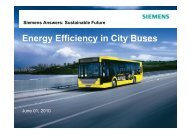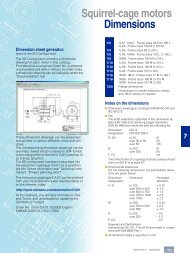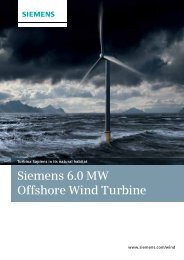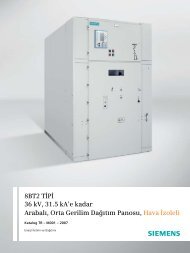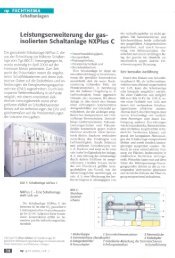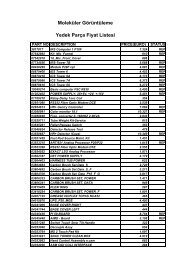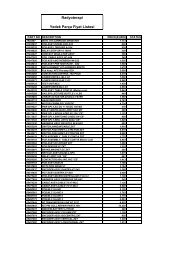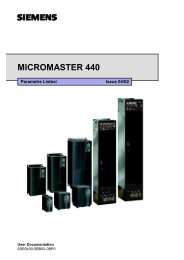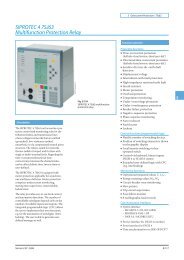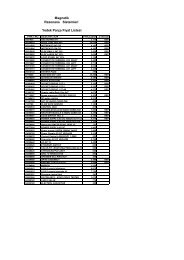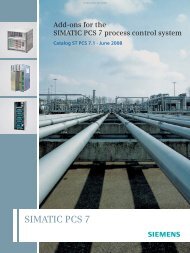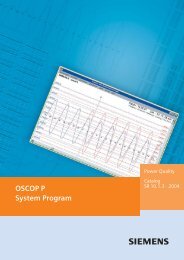Drehstrommotoren 1LG4 1LG6 1LG9 - Siemens
Drehstrommotoren 1LG4 1LG6 1LG9 - Siemens
Drehstrommotoren 1LG4 1LG6 1LG9 - Siemens
You also want an ePaper? Increase the reach of your titles
YUMPU automatically turns print PDFs into web optimized ePapers that Google loves.
ENGLISH<br />
2.5 Checking the insulation resistance<br />
The insulation resistance of the windings must be measured prior<br />
to initial startup of the machine, after long periods of storage or<br />
standstill (approx. 6 months).<br />
While the measurement is being taken<br />
and immediately afterwards, some<br />
WARNING<br />
of the terminals carry dangerous voltages<br />
and must not be touched.<br />
Insulation resistance<br />
- The minimum insulation resistance of new, cleaned or repaired<br />
windings with respect to ground is 10 MOhm.<br />
- The critical insulation resistance R crit<br />
is calculated first by multiplying<br />
the rated voltage U N<br />
, e.g. 0.69 kV AC, with the constant<br />
factor (0.5 MOhm/kV):<br />
R crit<br />
= 0.69 kV * 0.5 MOhm/kV = 0.345 MOhm.<br />
Measurement<br />
The minimum insulation resistance of the windings to ground is<br />
measured with 500 V DC. The winding temperature should then<br />
be 25 o C ± 15 o C.<br />
The critical insulation resistance should be measured with 500<br />
V DC with the winding at operating temperature.<br />
Checking<br />
If the minimum insulation resistance of a new, cleaned or repaired<br />
machine, which has been stored or at standstill for a prolonged<br />
period of time, is less than 10 MOhm, this may be due to<br />
humidity. The windings must then be dried.<br />
After long periods of operation, the minimum insulation resistance<br />
may drop to the critical insulation resistance. As long as<br />
the measured value does not fall below the calculated value of the<br />
critical insulation resistance, the machine may continue in operation.<br />
If it does, the machine must be stopped immediately.<br />
The cause must be determined, and the windings or winding sections<br />
repaired, cleaned or dried as necessary.<br />
2.6 Commissioning<br />
NOTE: Where the torque is very uneven (the drive of a piston-type<br />
compressor, for example), the inevitable result is a non-sinusoidal<br />
motor current, whose harmonics can lead to excessive system<br />
perturbation or excessive electromagnetic interference.<br />
In the case of converter-fed motors, high-frequency current or voltage<br />
harmonics in the motor cables can give rise to electromagnetic<br />
interference. That is why the use of shielded cables is recommended.<br />
Before commissioning, check that:<br />
- The minimum insulation resistances are adhered to<br />
- The rotor turns freely without rubbing<br />
- The motor is properly assembled and aligned<br />
- The transmission elements are correctly adjusted (e.g. belt tension)<br />
and the transmission element is suitable for the given operating<br />
conditions<br />
- All electrical connections, mounting screws and connecting elements<br />
are properly tightened and fitted<br />
- All protective conductors are properly installed<br />
- Any auxiliaries that may be fitted (brakes, speedometer, separate<br />
fan) are in working order<br />
- Touch protection guards are installed around moving and live<br />
parts<br />
- The maximum speed n max<br />
(see rating plate) is not exceeded.<br />
NOTE: The maximum speed n max<br />
is the highest operating speed<br />
permitted for short periods. It should be kept in mind that motor<br />
noise and vibration are worse at this speed, and bearing life is<br />
reduced.<br />
After motor installation, the brake, if<br />
CAUTION<br />
fitted, should be checked for proper<br />
functioning.<br />
It is not possible to formulate a complete check list. Other<br />
checks may also be necessary!<br />
3 Maintenance<br />
Safety precautions<br />
Before starting any work on the<br />
WARNING motor or other equipment, particularly<br />
before opening covers over<br />
live or moving parts, the motor must be properly isolated<br />
from the power supply. Besides the main circuits, any additional<br />
or auxiliary circuits that may be present must also<br />
be isolated.<br />
The usual “5 safety rules” (as set forth in DIN VDE 0105)<br />
are:<br />
- Isolate the equipment<br />
- Take effective measures to prevent reconnection<br />
- Verify equipment is dead<br />
- Earth and short-circuit<br />
- Cover or fence off adjacent live parts<br />
The precautions listed above should remain in force until<br />
all maintenance work is finished and the motor has been<br />
fully assembled.<br />
NOTE: Where motors are fitted with closed condense water openings,<br />
these should be opened from time to time to allow any accumulated<br />
condense water to be drained away.<br />
Condense water openings should always be at the lowest point of<br />
the motor!<br />
Fitting new bearings, grease lifetime, type of<br />
grease<br />
Under normal operating conditions, with horizontally mounted<br />
motors and coolant temperatures up to 40 °C, the grease lifetime<br />
should be:<br />
- approx. 40,000 operating hours for speeds of 1500 rpm<br />
- approx. 20,000 operating hours for speeds of 3000 rpm<br />
Irrespective of the number of operating hours, the grease should<br />
be renewed every 3 years because of ageing. In this case the<br />
bearings should be dismounted, washed and newly greased. The<br />
modifications with additional greasing are to be maintained according<br />
to instructions on the lubricating data plate.<br />
In the case of motors operating under special conditions, such as<br />
vertical motor position, frequent operation at maximum speed n max<br />
,<br />
heavy vibration, sudden load changes and frequent reversing operation,<br />
the bearing should be changed at considerably more frequent<br />
intervals than at the operating hours stated above.<br />
The motors are standardly equipped with radial ball bearings of 62<br />
… series or with option K36 - radial ball bearings of 63 … series<br />
which are provided with a cover plate (ZC3 version).<br />
The cover plate is arranged on that side of the bearing facing the<br />
frame (stator).<br />
NOTE: Notice the cover plate arrangement and the bearing clearance<br />
when changing the bearings because standard modifications<br />
can differ from special motors!<br />
The cover plate material should withstand temperatures from -<br />
20 °C to +150 °C, e.g. polyacryl-rubber (ACM).<br />
Type of grease for standard machines: (Fa. ESSO / UNIREX<br />
N3); grease lifetime and lubrication intervals are valid for this type<br />
of grease only.<br />
Compensatory greases must conform to DIN 51825-KL3N at least.<br />
In this case the lubrication intervals at KT > 25 °C are to be reduced.<br />
Ausgabe / Edition N14-0105 Bestell-Nr. / Order No. 35037000000057<br />
© <strong>Siemens</strong> AG 2000 All Rights Reserved DEUTSCH/ENGLISH/FRANCAIS/ESPANNOL/ITALIANO/SVENSKA/ÈESKY/ÏÎ ÐÓÑÑÊÈ<br />
<strong>Siemens</strong> AG - 5 -




